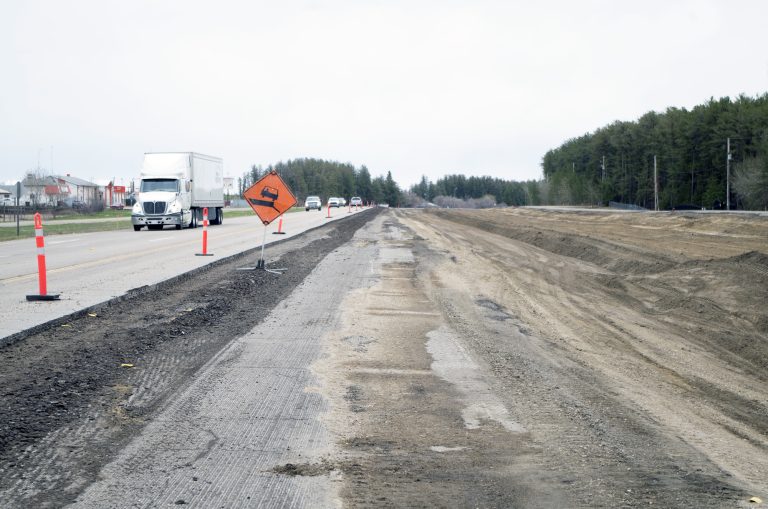
A local resident who lives in the area of Highway 3 is voicing her concerns over the next step of the province’s twin highway project in what she says is an “incredibly short-sighted and insane decision” by the Ministry of Highways.
In an email, Ellen MacNeill said that the Ministry’s plan to install 200 lights along Highway 3 will not only ruin the rural ambiance for the people that live nearby but could actually do the opposite of its intended purpose.
“I could see there being more deer hit in more accidents. If they’re confused and there’s that cement barrier and they don’t know what to do [and] here comes a car, they’ll either run off back to the ditch or they’ll try to jump over the barrier or just stand there,” said MacNeill in a phone call with the Herald. “If they just suddenly jump over the barrier, they could [go] into oncoming traffic and the other direction might not even see them until they’re in their windshield.”
MacNeill said she sent an email to Premier Scott Moe, MP Randy Hoback, MLA Nadine Wilson, the Ministry of Highways, and the RM of Buckland detailing the reasons why the province should hold off on rethink their decision to install that many lights along Highway 3.
Included in MacNeill’s email are some recommendations from her point-of-view as a local, including asking the Ministry of Highways to reconsider installing lights at only three intersections, rather than the entire six km stretch.
“The highway was made safe by the removal of 85 per cent of the old entrances and exits. There were 19 on-and-off crossroads between the overpass and the Shell River. Now there are only three,” read MacNeill’s email. “A cement barrier was put up down the middle, and the speed limit was dropped 90 [km] The highway is safe!! So, 200 lights down both sides is safety overkill!”
MacNeill’s email said that at night, Highway 3 is not as busy compared to Highway 2. She added that what makes the most sense is saving tax dollars both in installation costs and electrical bills that will be lighting up the whole 6 km of rural highway, largely lined with pine forests, for 365 days of the year.
“On top of the ugliness of the light poles, 200 LED lights will cause unnecessary and unsightly light pollution down a stretch of highway where at least 50 per cent of that length is bordered by pine forests,” according to her email. “This is a rural area, where people have moved to get away from city lights, making this a total mismatch for the nature of the area!”
If all else fails, the Ministry should consider making the lights only come on when cars go by or dim them after rush-hour traffic has died down, she added.
MacNeill said the Government of Saskatchewan responded to her email that they wouldn’t be heeding any of her suggestions and would be going forward with the installation.
In an phone interview on Friday afternoon, Highways Minister Jeremy Cockgrill said the province is open to working with local residents to ensure impacts on them are mitigated, but improving safety on the busy corridor for the travelling public is their priority.
“The reality is, is that this is a busy highway,” said Cockgrill. “There’re over 6,000 vehicles a day that travel on this stretch of highway.
MacNeill said that while the highway does get busy during the day, it significantly decreases after 9 p.m.
“Why do we have to have these lights on when there’s so little traffic at night?” asked MacNeill. “Why don’t [they] just light up the intersections and not the while stretch of highway, which will be a glowing light in the living room windows of many people?”
Cockrill said that at the end of the day, it’s important to have continuous lighting to make nighttime driving safer.
“We’re not just concerned about vehicles interacting with each other, but it’s also vehicle potentially interacting with wildlife or other dangers on the road,” added Cockrill. “It’s certainly the Ministry’s position that continuous lighting helps to make that corridor really as safe as possible.”
MacNeill claims that she was told in emailed response from the Ministry of Highways that the planning for the highway twinning project happened during the COVID-19 pandemic, so there were no public forums that took place where residents could voice their opinions and concerns.
“Engineers came up with this ridiculous plan which was approved by the powers that be and the people impacted the most by the plans weren’t consulted,” continued her email, where she added that a survey should be conducted of all the people living along the highway to ask their opinion.
Cockrill said while there were no in-person open houses held due to safety measures, the Ministry held an online consultation period in the summer of 2021. A website was also created where residents could leave comments and see information about the project.
“We have public consultation opportunities any time we do a significant project through the Ministry of Highways,” said Cockrill. “We received public input from the RM of Buckland, the City of Prince Albert, related to improving safety on the corridor. We’ve been hearing from community members for several years that there is a desire for the highway to be twinned to make travel more safe.”
As part of the $21.4 million twinning project on Highway 3 between Prince Albert and Shellbrook, a concrete median barrier in the centre of the road was added, the speed limit was lowered to 90 km, with the next step being the light pole installation.
